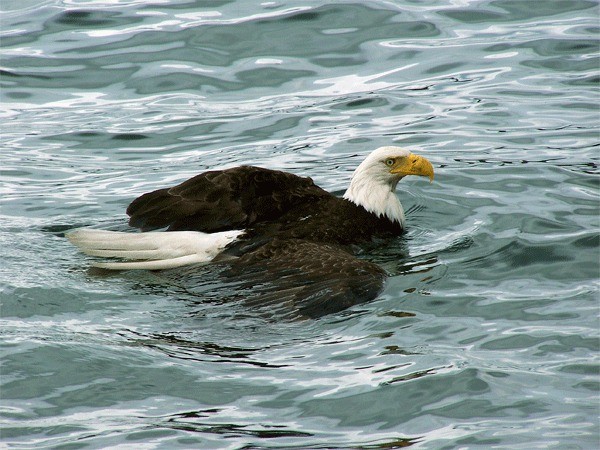The efforts of kind-hearted boaters, a park ranger and a veterinarian weren’t enough to save an injured bald eagle that was pulled from Puget Sound near Deception Pass late Thursday afternoon.
At around 3:30 p.m., passengers and crew from a Deception Pass Tours boat noticed the eagle trying to swim about a half mile west of Deception Pass State Park.
“As we got closer, we clearly saw it was a bald eagle,” said Brett Ginther, owner of Deception Pass Tours. He first contacted the state department of Fish and Wildlife to figure out the best way to deal with the eagle. He finally decided they should try to capture it.
Once they got close enough, they noticed the eagle was injured.
“This one only had one wing that was working,” Ginther said.
One of his employees and a passenger used a 40-gallon trash can to scoop the eagle to safety.
Eager to get out of the chilly water, Ginther said the eagle quickly swam into the trash can and to safety. The five passengers and crew wrapped it in jackets to warm it up and the boat returned to Cornet Bay at Deception Pass State Park.
The tour boat company turned the eagle over to a park ranger, who took it to a nearby veterinarian for treatment.
Veterinarian Eric Anderson examined the eagle and determined that the joint on its right wing had been dislocated. Since it was clear the eagle would never fly again, it was euthanized, said Anderson, who is owner of Best Friends Veterinarian Center and president of the Wildlife Care Clinic in Oak Harbor. He said the eagle was at least 2 years old and weighed about 10 pounds.
He said the clinic sees about five to six bald eagles a year.
The dead eagle will be turned over to the U.S. Fish and Wildlife Service. It will eventually end up in the National Eagle Repository, where a necropsy will be performed.
Doug Zimmer, spokesperson with the U.S. Fish and Wildlife Service said it’s important to figure out the manner in which an eagle dies. He said eagles are commonly struck by vehicles. However, they are especially susceptible to secondary poisoning caused by eating a contaminated animal. He said eagles are especially sensitive to lead contamination caused by eating ammunition.
Once the necropsy is completed, the repository makes the eagles available to qualified Native American tribes that use feathers and parts in religious ceremonies.



